The amount of money needed to deliver net zero still exceeds annual spending on emissions reductions, but achieving the required investment appears tantalizingly within reach.
CPI’s third annual study with international law firm A&O Shearman, ‘How big is the net zero financing gap?’, analyzes the differential between committed climate finance and the capital needed to decarbonize the global economy by 2050. Building on data from CPI’s Global Landscape of Climate Finance, the study reinforces that if the current trajectory of climate investment (26% compound annual growth rate (CAGR) between 2020 and 2023) is sustained in the coming years, annual climate finance flows could approach USD6.2 trillion by 2029, the lower bound of estimated needs for the period 2024 to 2030.
Graphic: A&O Shearman
Leveraging A&O Shearman’s global policy expertise, the report further explores recent policy developments that influence the trajectory of global climate-related investment, as well as areas where policymakers, governments, and investors can focus their efforts to align capital flows with the goals of the Paris Agreement.

